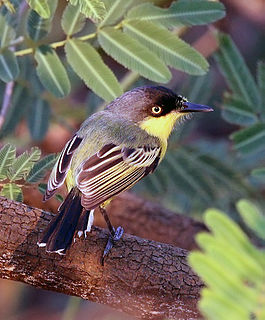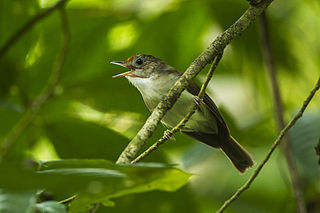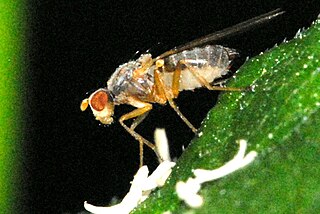
Geranium is a genus of 422 species of flowering annual, biennial, and perennial plants that are commonly known as the cranesbills. They are found throughout the temperate regions of the world and the mountains of the tropics, but mostly in the eastern part of the Mediterranean region.

Geranium cinereum, the ashy cranesbill, is a species of flowering plant in the family Geraniaceae, native to the Pyrenees. Growing to 50 cm (20 in) tall and wide, it is a small, deciduous or semi-evergreen perennial usually grown for low ground cover, rockeries or underplanting larger subjects like roses. Leaves are deeply divided and grey-green - whence The Latin specific epithet cinereum “ash-grey”.. It flowers in summer, with striking black-eyed flowers with black stamens. The plant grows in full sunlight, and is hardy down to −15 °C (5 °F).

The common tody-flycatcher or black-fronted tody-flycatcher is a very small passerine bird in the tyrant flycatcher family. It breeds from southern Mexico to northwestern Peru, eastern Bolivia and southern Brazil.
Pleurodema cinereum is a species of frog in the family Leptodactylidae. It is found in the Andes in northwestern Argentina, Bolivia, and southeastern Peru. Its common name is Juliaca four-eyed frog, after its type locality, Juliaca. Pleurodema borellii is possibly a junior synonym of this species.

The cinereous conebill is a species of bird in the family Thraupidae. The term cinereous describes its colouration. It is found in Bolivia, Chile, Colombia, Ecuador, and Peru. Its natural habitats are subtropical or tropical moist shrubland, subtropical or tropical high-altitude shrubland, and heavily degraded former forest.

The scaly-crowned babbler is a species of bird in the Pellorneidae family. It is found in Brunei, Cambodia, Indonesia, Laos, Malaysia, Thailand, and Vietnam. Its natural habitat is subtropical or tropical moist lowland forests.
The ashy darter is a species of darter endemic to the eastern United States.

Tetramolopium is a genus of plants in the aster tribe within the daisy family.

Geranium subcaulescens is a species of flowering plant in the geranium family Geraniaceae, that is native to Italy, Turkey and the Balkans. A low, mounded evergreen perennial, it typically grows to 8 in (20 cm) tall by more than 11 in (28 cm) broad, with grey-green orbicular and lobed leaves, and masses of bright magenta pink flowers with black centres in summer.

Cyanthillium cinereum is a species of perennial plants in the sunflower family. The species is native to tropical Africa and to tropical Asia and has become naturalized in Australia, Mesoamerica, tropical South America, the West Indies, and the US State of Florida.

Solanum cinereum is a nightshade, known by the common name Narrawa burr. It is native to open woodland in south eastern Australia.

Heleomyzinae is a subfamily of flies in the family Heleomyzidae. There are about 19 genera and more than 400 described species in Heleomyzinae.
Lepidostoma cinereum is a species of bizarre caddisfly in the family Lepidostomatidae. It is found in North America.
Anorostoma alternans is a species of fly in the family Heleomyzidae.
Anorostoma is a genus of flies in the family Heleomyzidae. There are about 17 described species in Anorostoma.

Heleomyzini is a tribe of flies in the family Heleomyzidae. There are about 10 genera and more than 180 described species in Heleomyzini.
Anorostoma maculatum is a species of fly in the family Heleomyzidae.

Armases cinereum, known generally as the squareback marsh crab or wharf crab, is a species of true crab in the family Sesarmidae. It is found in the western Atlantic Ocean.

Armases is a genus of true crabs in the family Sesarmidae. There are about 13 described species in Armases.
Xeranobium cinereum is a species of death-watch beetle in the family Ptinidae. It is found in North America.













